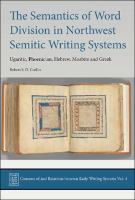The Semantics of Word Division in Northwest Semitic Writing Systems
Ugaritic, Phoenician, Hebrew, Moabite and Greek (Volume 4)
Author(s)
Crellin, Robert S.D.
Collection
Knowledge Unlatched (KU)Language
EnglishAbstract
Much focus in writing systems research has been on the correspondences on the level of the grapheme/phoneme. Seeking to complement these, this monograph considers the targets of graphic word-level units in natural language, focusing on ancient North West Semitic (NWS) writing systems, principally Hebrew, Aramaic, Phoenician and Ugaritic. While in Modern European languages word division tends to mark-up morphosyntactic elements, in most NWS writing systems word division is argued to target prosodic units, whereby written ‘words’ consist of units which must be pronounced together with a single primary accent or stress. This is opposed to other possibilities including Semantic word division, as seen in Middle Egyptian hieroglyphic.
The monograph starts by considering word division in a source where, unlike the rest of the material considered, the phonology is well represented, the medieval tradition of Tiberian Hebrew and Aramaic. There word division is found to mark-up ‘minimal prosodic words’, i.e. units that must under any circumstances be pronounced together as a single phonological unit. After considering the Sitz im Leben of such a word division strategy, the monograph moves on to compare Tiberian word division with that in early epigraphic NWS, where it is shown that orthographic wordhood has an almost identical distribution. The most economical explanation for this is argued to be that word division has the same underlying basis in NWS writing since the earliest times. Thereafter word division in Ugaritic alphabetic cuneiform is considered, where two word division strategies are identified, corresponding broadly to two genres of text, poetry and prose. 'Poetic' word division is taken as an instance of mainstream ‘prosodic word division’, while the other is morphosyntactic in scope anticipating later word division strategies in Europe by several centuries. Finally, the monograph considers the digital encoding of word division in NWS texts, especially the difficulties, as well as potential solutions to, the problem of marking up texts with overlapping, viz. morphosyntactic and prosodic, analyses.
Keywords
Language Arts & Disciplines; LinguisticsISBN
9781789256802Publisher
Oxbow BooksPublisher website
https://www.oxbowbooks.com/oxbow/Publication date and place
2021Imprint
Oxbow BooksClassification
Linguistics


 Download
Download